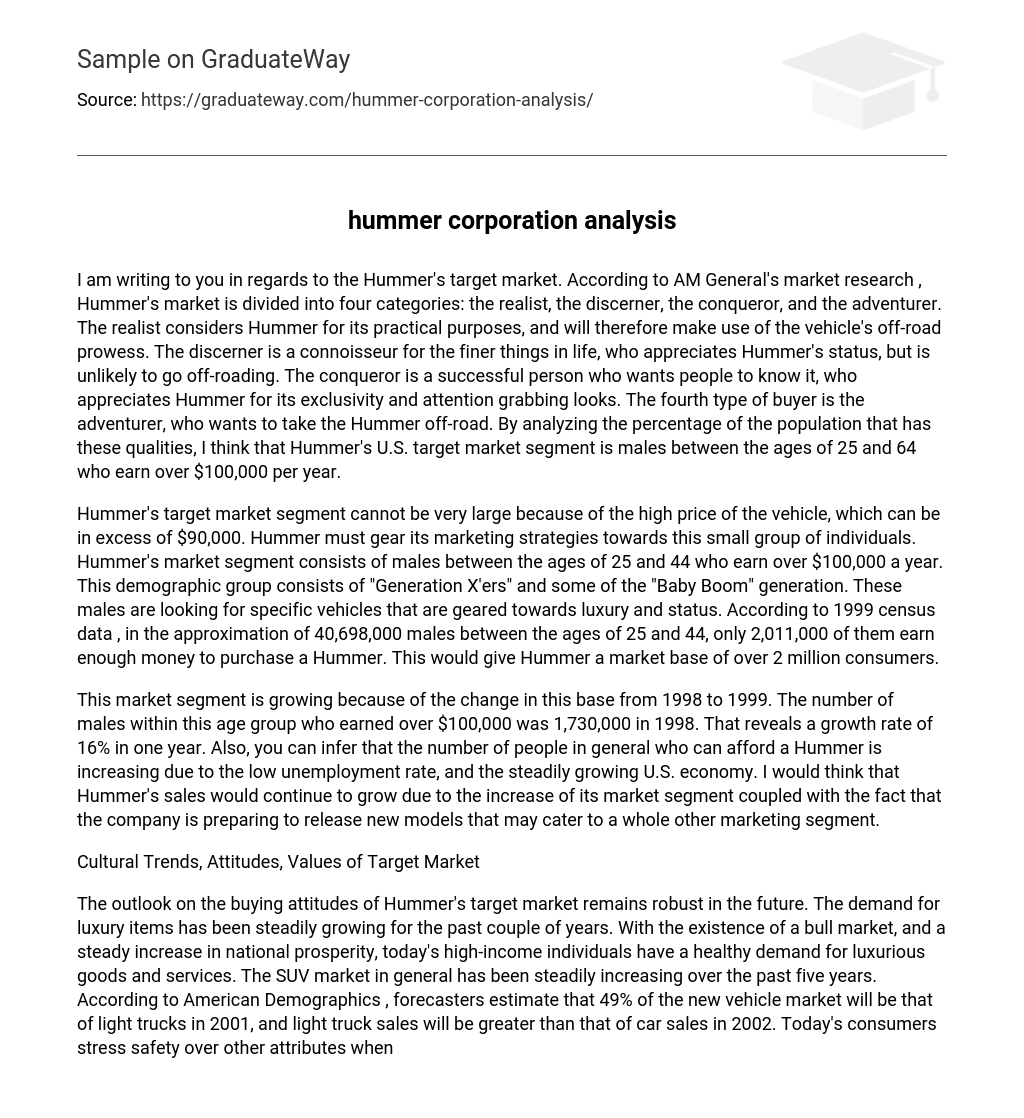The purpose of this message is to discuss the target market for the Hummer, based on information from AM General’s market research. According to their findings, the Hummer’s market can be categorized into four groups: the realist, discerner, conqueror, and adventurer. The realist group consists of individuals who see the practicality and off-road capabilities of the Hummer. The discerner group includes individuals with a refined taste for luxury and value owning a Hummer for its status but are less likely to go off-roading. The conqueror group comprises successful individuals who want to showcase their status and appreciate the exclusive and attention-grabbing appearance of the Hummer. Lastly, there is the adventurer group who are interested in taking the Hummer off-road. By evaluating these characteristics within the population, it is determined that men aged 25 to 64 with an annual income exceeding $100,000 form the primary target market segment for Hummer in the United States.
Hummer’s target market segment is limited in size due to its high price, which can exceed $90,000. As a result, the company must focus its marketing strategies on a smaller group of individuals: males aged 25-44 with an annual income exceeding $100,000. This demographic includes both “Generation X’ers” and members of the “Baby Boom” generation who are interested in luxury and status-oriented vehicles.
Based on the 1999 census data, out of approximately 40,698,000 males aged 25-44, only 2,011,000 have the financial means to afford a Hummer. Thus, Hummer’s potential consumer base would consist of over 2 million people.
The market segment is growing as a result of the changes in the base from 1998 to 1999. Within one year, there was a 16% rise in the number of males above the $100,000 threshold, totaling 1,730,000 individuals. This indicates that more people are now capable of purchasing a Hummer due to the robust U.S. economy and low unemployment rate. With an expanded market segment and new model introductions, it is highly probable for Hummer’s sales to keep increasing.
Hummer’s target market continues to show strong buying attitudes, ensuring a promising future. The demand for luxury items, especially among high-income individuals with a penchant for luxurious goods and services, has consistently increased. The SUV market has also experienced steady growth over the past five years. According to American Demographics, forecasters anticipate that light truck sales will exceed car sales in 2002, with light trucks accounting for 49% of the new vehicle market in 2001. This rising demand can be attributed to consumers’ prioritization of safety when purchasing vehicles since SUVs are generally perceived as safer than cars during crashes. Additionally, empty nest baby boomers are favoring SUVs over sedans. Consumers are drawn to the current sleek styling of SUVs that flawlessly combine ruggedness and beauty. Moreover, the image factor significantly influences consumer trends as driving an SUV symbolizes strength and confidence.
These consumer values are essential for evaluating Hummer’s position in the SUV market. GM needs to promote the Hummer as a vehicle that can elevate the driver’s status and reflect a sense of sophistication. The market segment of Hummer primarily values high social image and the appreciation of luxury. Therefore, Hummer should design its marketing strategy around the concept of a luxurious alternative to a sedan that enhances the driver’s image. To attract wealthy individuals, Hummer must ensure that its vehicle functions as a status symbol.
Hummer’s primary competitors in the luxury SUV market include Range Rover, Lincoln, and Lexus. These manufacturers all offer SUVs that are considered top-tier in the industry and are seen as status symbols. However, Hummer falls behind these competitors in terms of performance and ride quality. While the other SUVs provide a smoother ride and a faster acceleration, they also offer similar luxury features like TVs and navigation systems. Additionally, they have a higher passenger capacity and are slightly more affordable than the Hummer (see exhibit A). Nevertheless, Hummer differentiates itself through its unparalleled off-road performance, thanks to its military background.
Regularly monitoring specific web newsgroups can provide valuable insights into consumer needs and desires. Within these groups, two key observations can assist in the marketing process. First, consumers anticipate something new from Hummer in the near future. Second, financial concerns surrounding a large vehicle like Hummer are prevalent among consumers. By leveraging these consumer preferences, GM can customize their marketing strategy accordingly.





